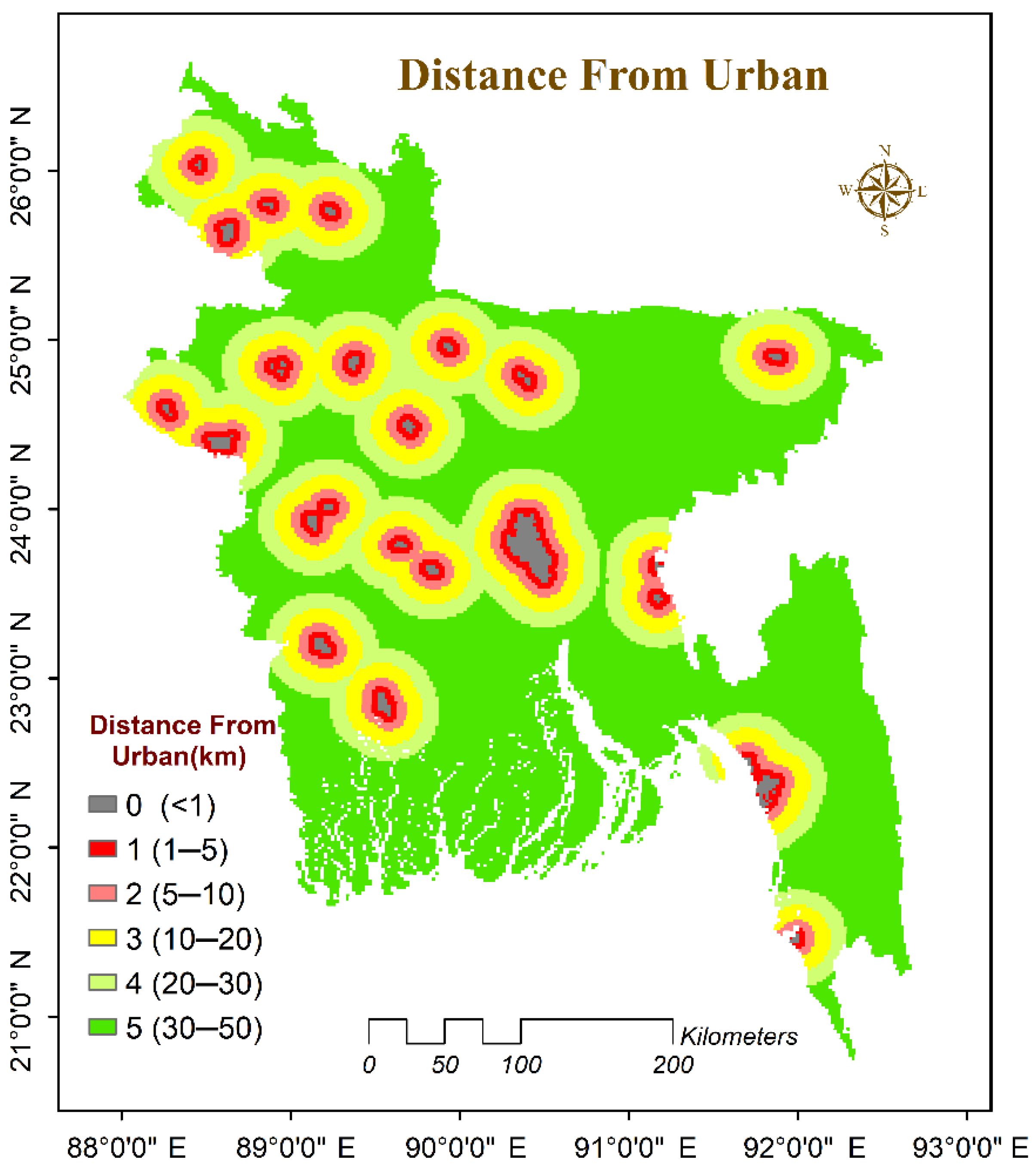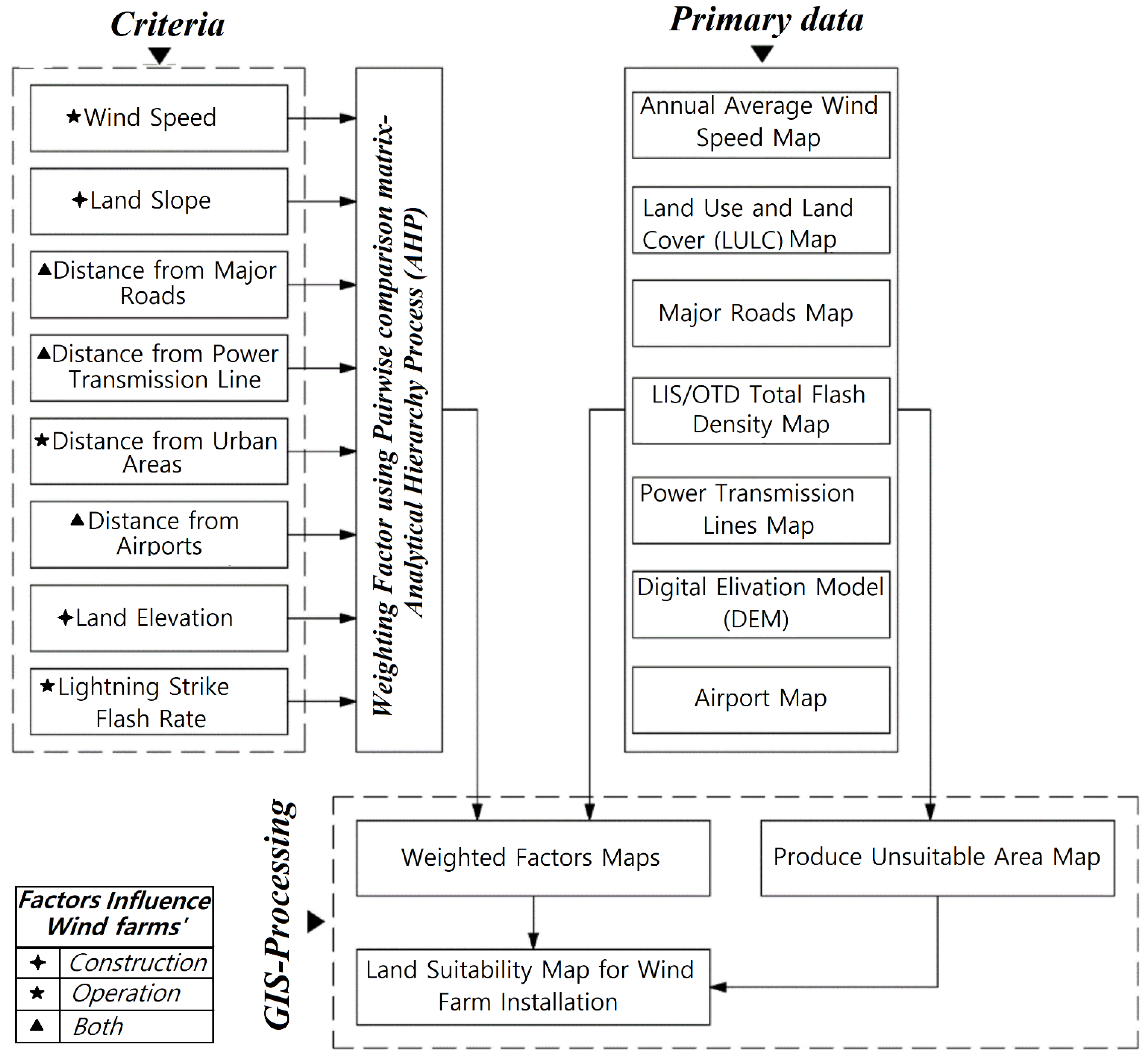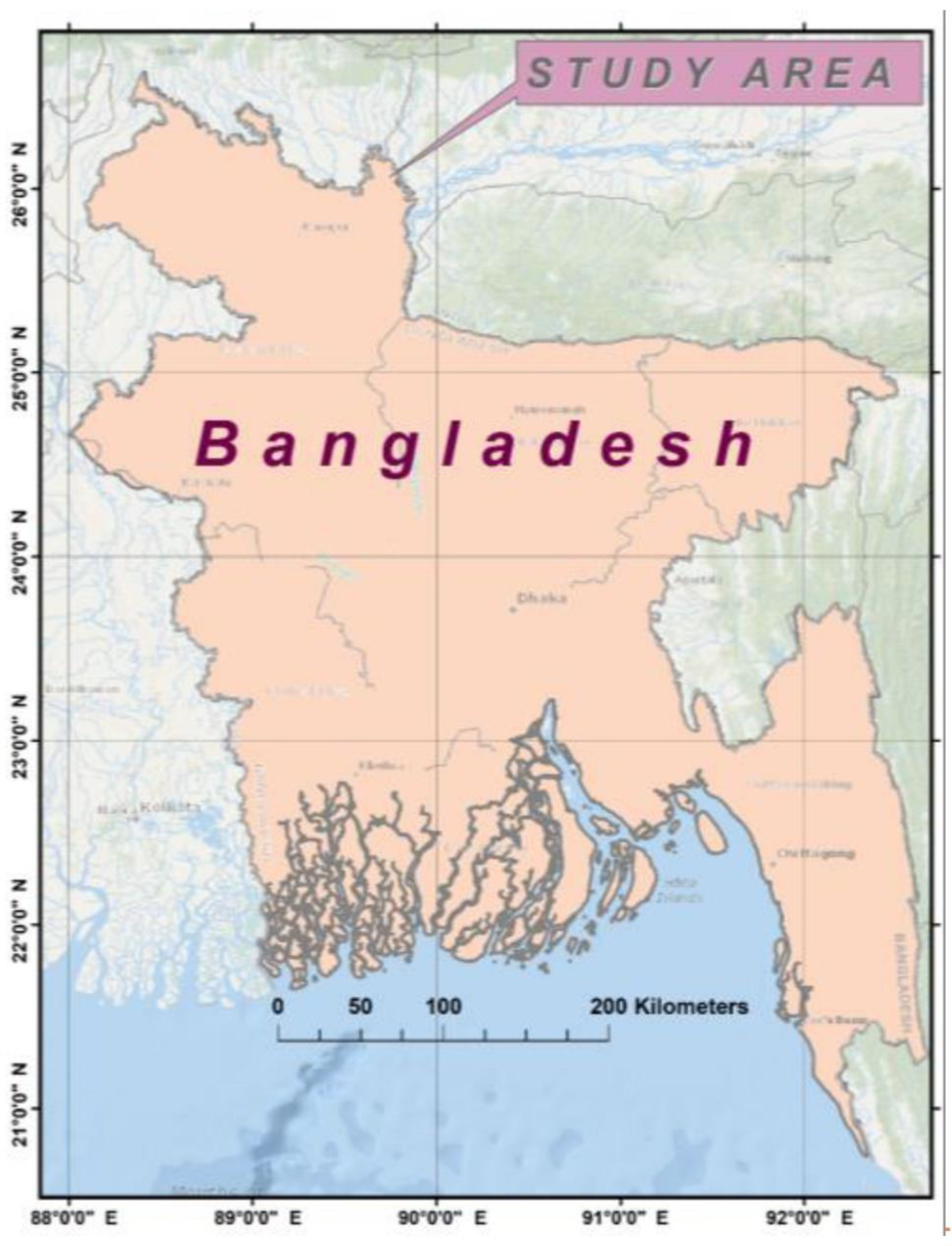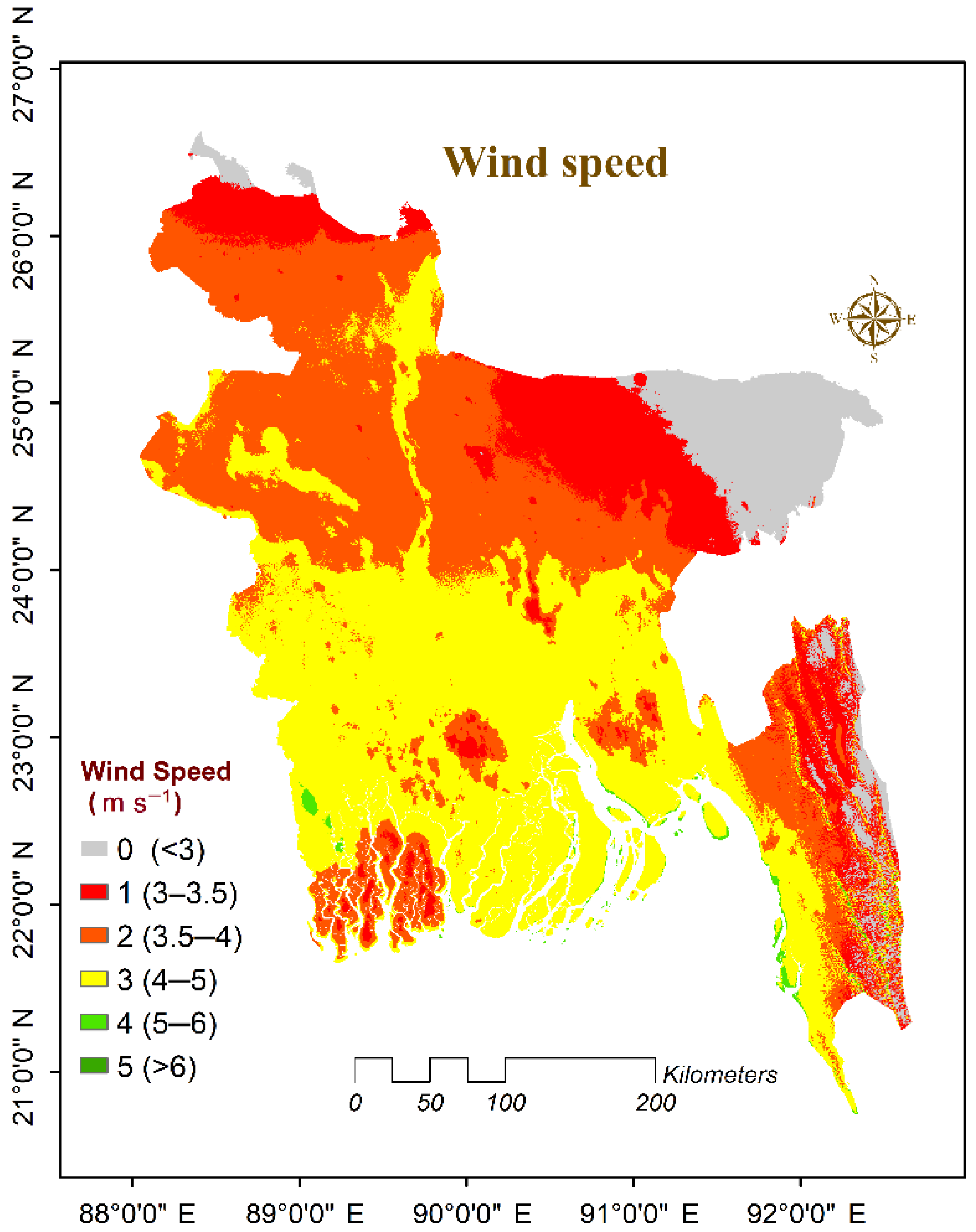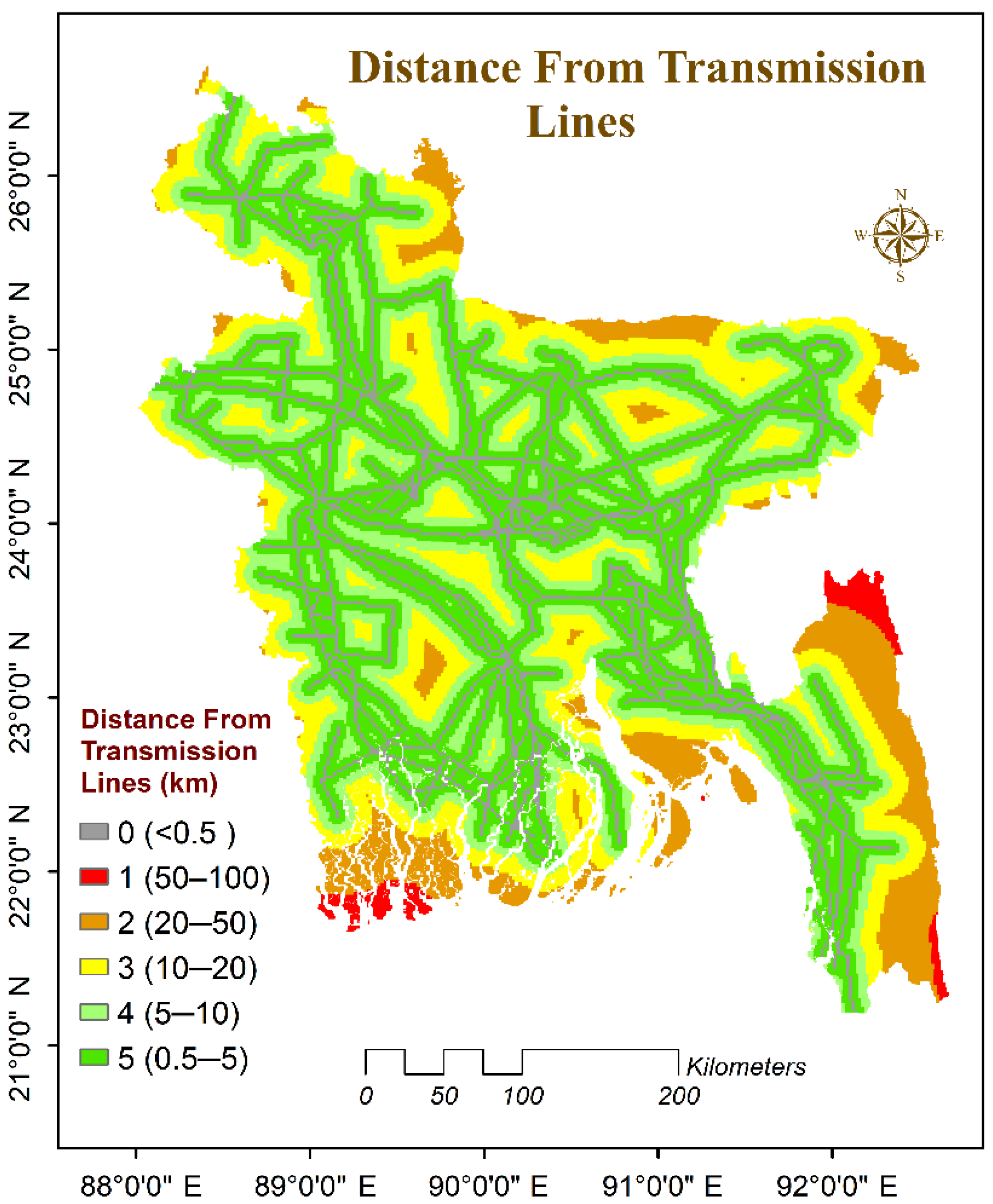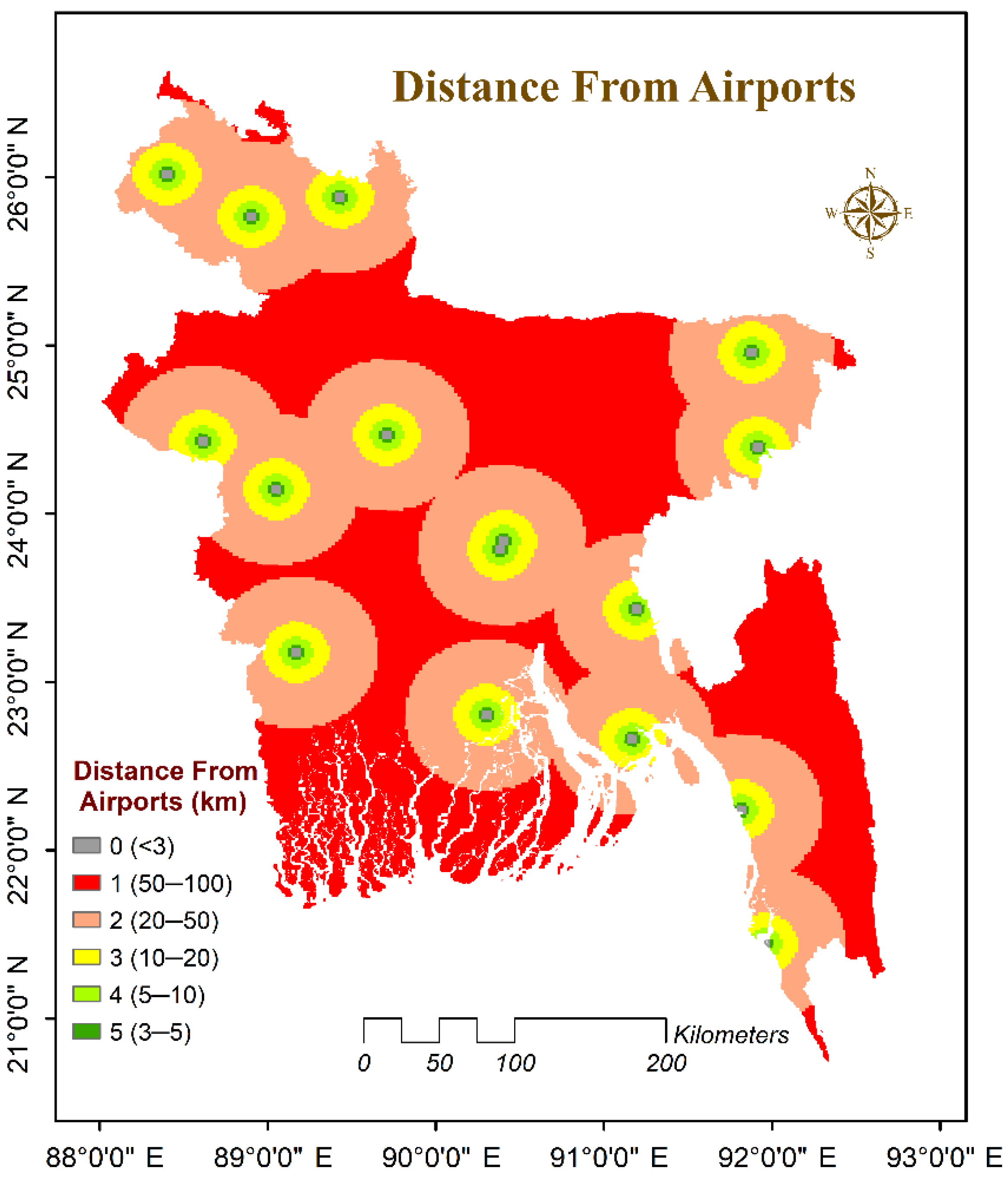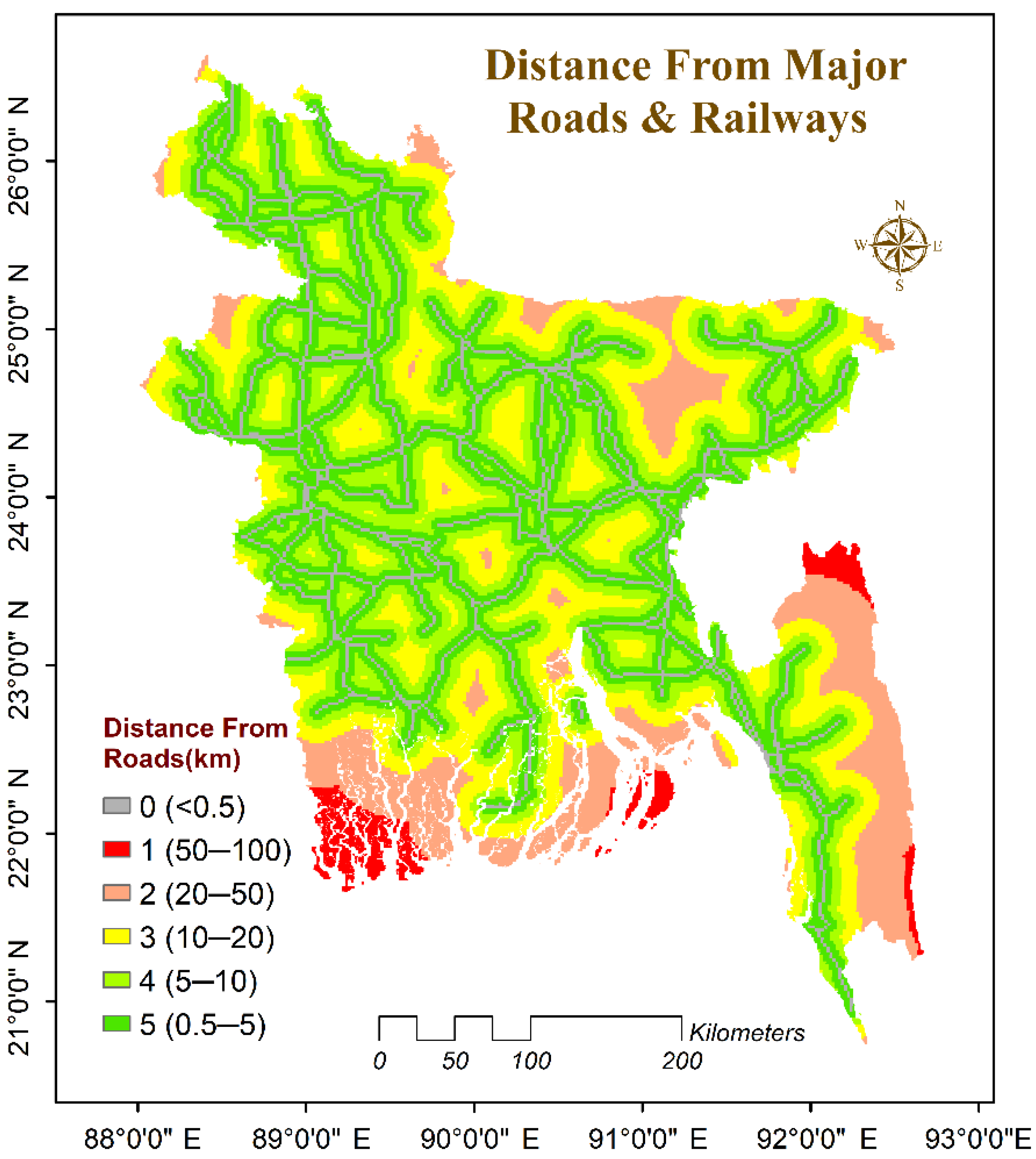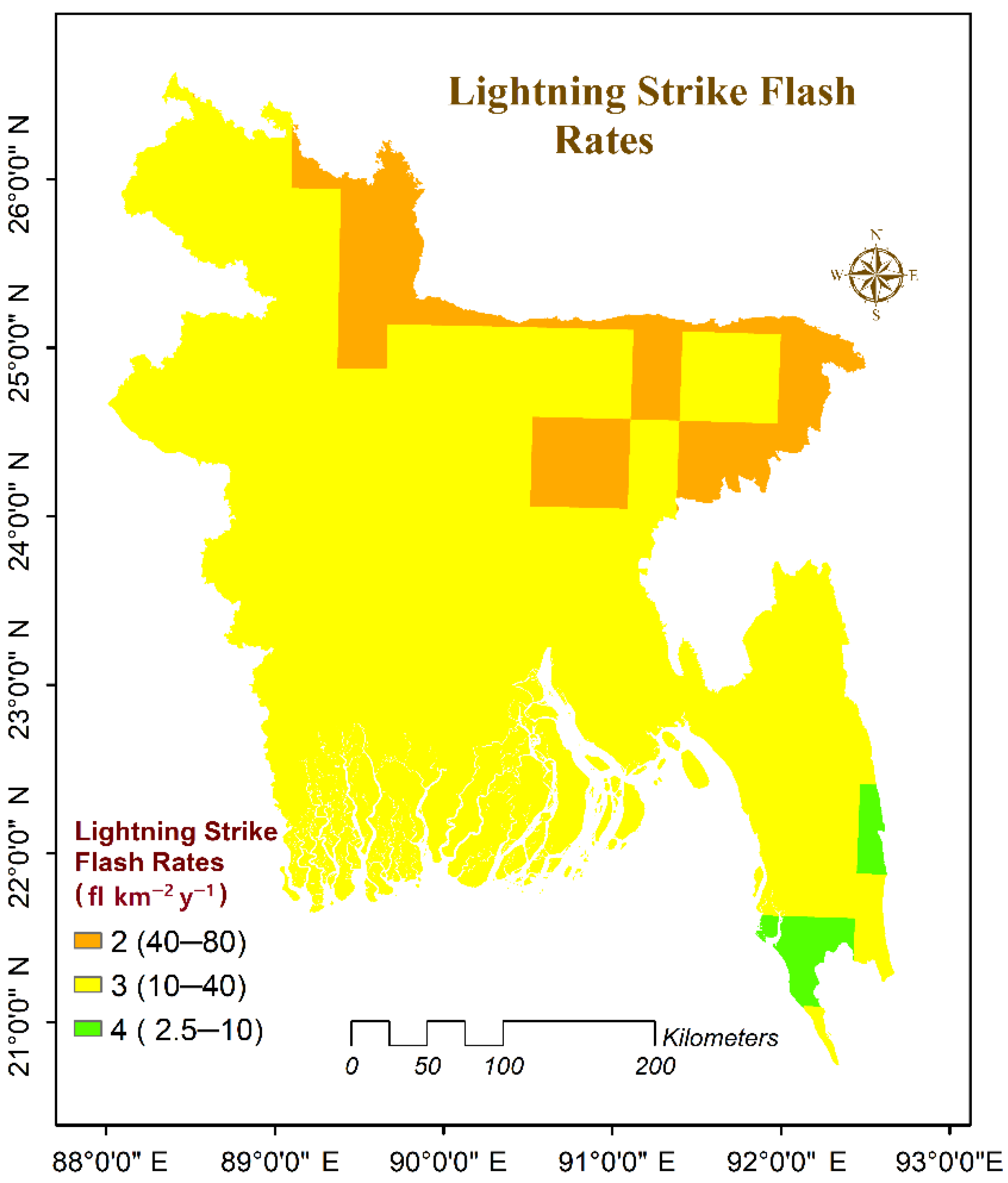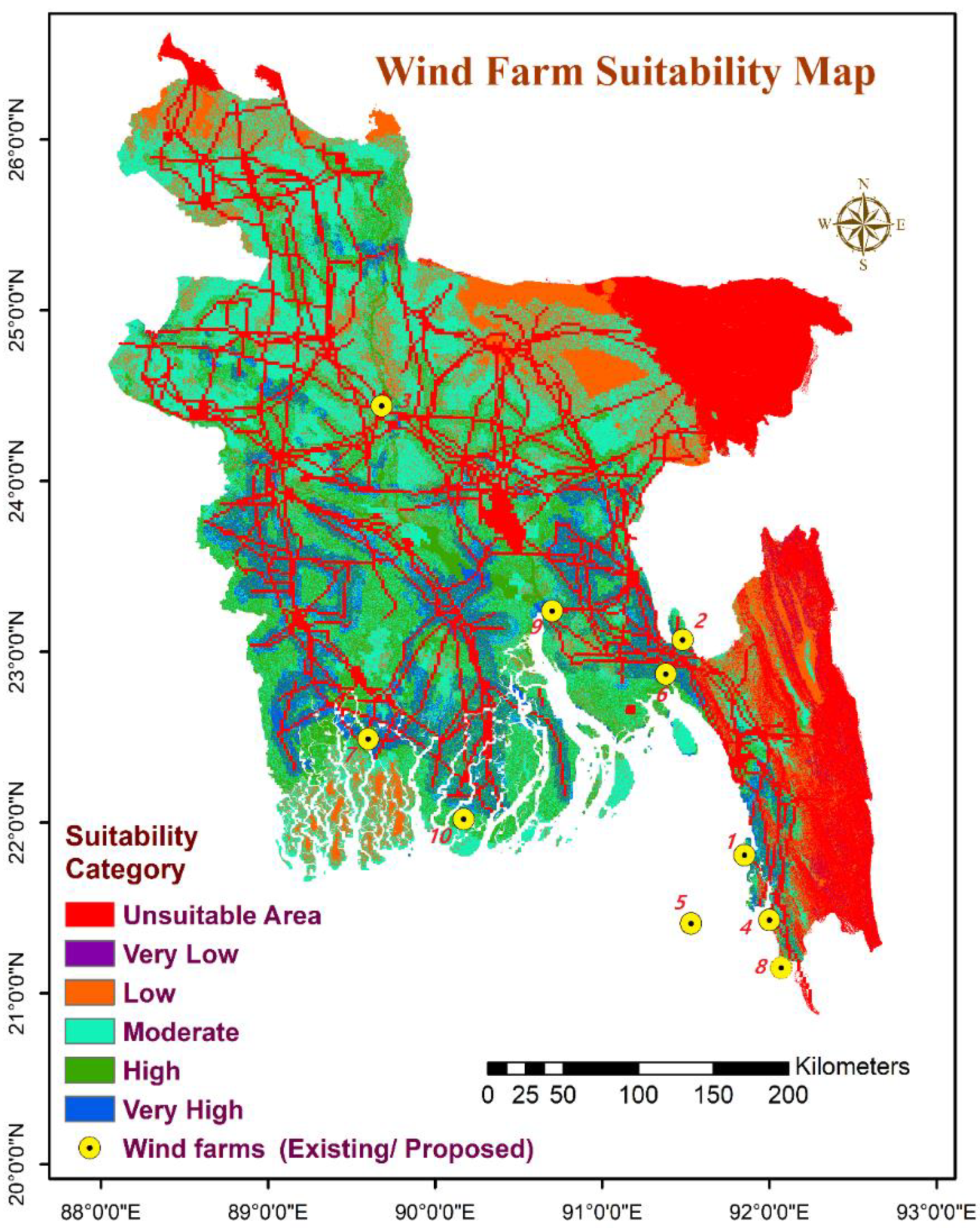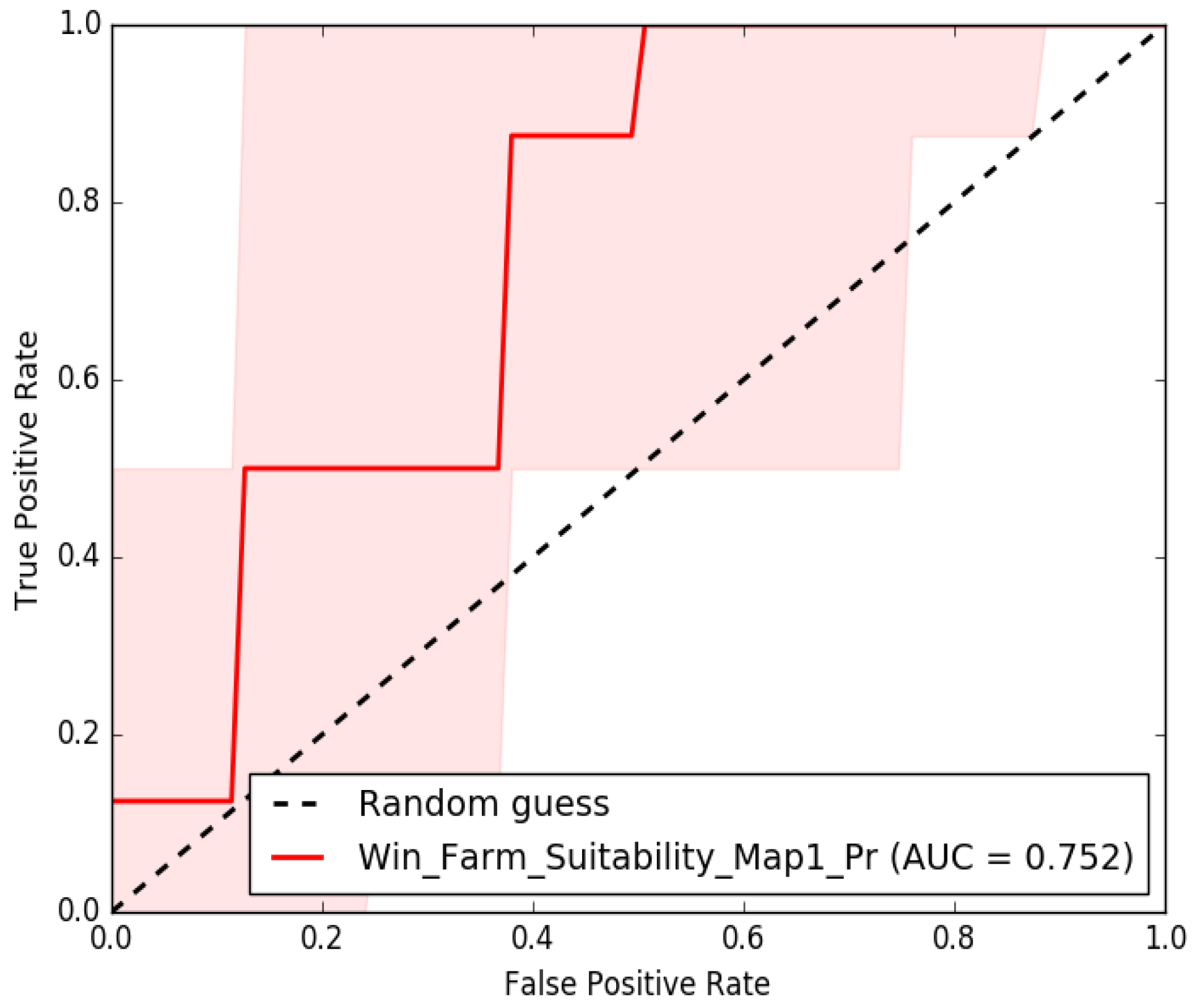1. Introduction
Energy is one of the most important factors driving the expansion of the global economy and industrial sector [
1,
2]. For a developing country like Bangladesh, to ensure the energy reserve and its sustainable supply is the most crucial factor in the time of globalization. The increasing demand for electricity in Bangladesh is not being met by the available energy sources. Every day, the availability of fossil fuels decreases. Bangladesh’s industrialization is approaching its most critical point ever in terms of energy issues due to a lack of energy. This issue can be mitigated in part by shifting the energy paradigm and embracing renewable energy options, wind energy being the most prominent. Wind energy is capable of producing mechanical energy or electricity without polluting the environment [
3].
Nevertheless, natural gas and coal are the primary power generation sources in Bangladesh’s power sector, which makes the country heavily dependent on fossil fuels. On the other hand, natural gas generates 62.9% of Bangladesh’s electrical power, with the rest coming from other sources like diesel (10%), coal (5%), heavy oil (3%) and renewables (3.3%) [
4]. Additionally, fossil fuel consumption directly contributes to an increase in greenhouse gas (GHG) levels in the atmosphere. These three (CO
2, SO
2, and NO
x) GHGs have been identified as a growing problem for the global community because of their long-term environmental and ecological impacts and, more crucially, their impact on climate change. Industrialization and widespread reliance on fossil fuels are driving an exponential rise in CO
2 emissions [
5]. Solar, biomass, wind, and hydropower are just a few of the climate-change mitigation options currently being considered for potential use in developing countries [
5]. Bangladesh faces a number of energy development challenges, including the high cost of electricity subsidies and the negative impact of climate change on the country’s dwindling hydroelectric generation resources. Bangladesh’s development goal is to ensure that all citizens have access to modern, affordable electricity. The government of Bangladesh is working to develop a clean and reliable electrical energy supply because of Bangladesh’s high wind and solar potential. Wind energy is one of the newest and fastest-growing renewable energy sources because it is clean, renewable, and has a minimal impact on humans and the environment. Wind turbines (WTs) are also easy to set up and operate, with low costs of upkeep and repair [
5].
The implementation of wind energy projects necessitates careful consideration of a wide range of variables. Preliminary economic, environmental, and land use requirements must be taken into account when selecting an investment site for a wind power plant (WPP). Additional considerations, such as the impact of WTs on wildlife, shadow flashing, visual impacts, and electromagnetic interference must be taken into account when deciding where to build a wind farm [
6]. As a result, the windiest places aren’t always the best; rather, a variety of economic, physical, and ecological factors must be considered in order to select the ideal locations [
7]. Wind farm locations are determined utilizing multi-criteria decision-making (MCDM) techniques. Rating method, weighted sum method (WSM), ranking method, Weighted Linear Combination (WLC), analytical hierarchy process (AHP), Boolean overlay operation, analytic network process (ANP), trade-off analysis method, concordance analysis, Order Weighted Average (OWA), and Elimination Et Choice Translating Reality (ELECT) are MCDM techniques that can be combined with the Geographic Information Systems (GIS) environment [
8]. The WSM is commonly utilized to find solutions to decision-making issues that only involve a single dimension; however, its application in scenarios involving multiple dimensions is notoriously difficult [
9]. In addition to this, the ELECTRE method is ideal for use in settings where there are a variety of factors to consider and a considerable number of alternatives to choose from. Despite this, it is not a foolproof method for picking the best available alternative [
10]. On the other hand, the AHP is regarded as the most popular MCDM technique in the literature for analyzing renewable energy sites because it is simple, straightforward, and can examine the consistency of the decision. It has the advantage of simplifying decision-making challenges that require a high level of consistency and flexibility. The framework can also combine quantitative and qualitative criteria. AHP is a mathematical method that assigns a relative weight to each criterion based on the decision-makers’ expert opinions when comparing paired criteria [
11,
12].
Utilizing various multi-criteria GIS modeling approaches was the primary objective of this research project, which was designed to identify potential sites for the construction of wind farms. In spite of the fact that a few studies have been carried out on wind energy prospects, not a single study has been carried out in the past on the process of site selection in Bangladesh. To the best of our knowledge, this is the first in-depth study that has been conducted in Bangladesh with the purpose of simultaneously utilizing AHP and GIS to identify potential locations for siting wind farms. In light of this, in the current investigation, we are taking into account the points of view of both regional experts and an extensive literature review in order to provide an in-depth basis for AHP calculations. It is anticipated that this study will provide valuable insights for national-scale applications of wind energy due to the fact that its spatial scope for the siting of wind farms encompasses the entirety of the country.
2. Materials and Methods
This research intends to develop a method that can categorize the land that is available for the construction of wind farm projects into different levels, based on the degree to which it is suitable for such endeavors. In order to accomplish this objective, several steps have been determined, as shown in
Figure 1. The first step in the research process is to choose the case study, then to conduct a literature review to investigate the scope of the need for projects of this kind and determine whether or not the proposed location is suitable for such projects. Next, based on the specifics of the case study and the technical challenges involved, decide which aspects of the land’s suitability for wind farms are the most important. As a consequence of this analysis, particular weights are assigned to each factor in order to develop an index that can determine the suitability of land. The AHP was utilized in order to arrive at these final weights. The final suitability map is then produced with the help of GIS, a map which is used for spatial analysis and the integration of multiple factors into the proposed index in order to locate areas that are not suitable.
2.1. Study Area
The geographical extent of the study region, Bangladesh, can be found in South Asia between the coordinates 20°34′ N and 88°01′ E and 26°38′ N and 92°41′ E. Bangladesh is encircled on three sides by the country of India (i.e., west, north, and northeast). It shares a border with Myanmar on the southeast, while the southern side encompasses the Bay of Bengal and has a coastline that is more dispersed (
Figure 2).
2.2. Land Suitability Evaluation Factors
Wind speed, slope, city proximity, elevation, distance between power grid and transmission system, distance from airports, distance from major highways and railways and lightning strike flash rates are eight assessment factors that were established and used as input to ArcMap 10.8 to conduct a geographic study and choose Bangladesh’s optimal wind farm sites.
2.2.1. Wind Speed
Wind firms place the greatest emphasis on wind velocity. Wind turbines generate more electricity when the wind speed exceeds a certain threshold. In previous research studies, a variety of wind speed threshold values were identified. This study concludes that the location of a wind farm is inappropriate if the average wind speed is less than 3 ms
−1. However, due to the potential for damage, WT equipment is prohibited in regions where the average wind speed exceeds 20 m s
−1 [
13].
2.2.2. Slope
In order to locate wind farms in the best possible location, slope is an important technical parameter. Maintenance and equipment installation costs rise because of the difficulty in accessing these locations due to steep slopes. Flat and low-slope areas are commonly recommended for wind farm development in order to avoid the difficulties of wind farm construction. Conversely, areas with a slope greater than 15% are omitted from the final suitability map [
14]. However, in this study, the slope factor was calculated using data from a digital elevation model (DEM).
2.2.3. Distance from Urban Areas
Wind farms are a source of mechanical and aerodynamic noise, visual disturbances, and shadow flashes, among other issues. A minimum safe distance must be maintained from urban and residential areas to the wind farm site in order to evict the residents of the wind farm’s neighboring regions. For the wind farm project to be economically viable, a balance must be maintained between maintaining a safe distance from communities and rising transmission power losses and costs. Consequently, the distance between urban and residential areas must be calculated with care, taking into account all lateral factors. In this case, locations 1 km from residential areas are deemed suitable for wind farm development [
15]. To develop a suitable data format for further use, this study used vector data from urban regions using the “Euclidean Distance” program.
2.2.4. Elevation
Wind direction and speed are greatly influenced by the site’s elevation. Typically, wind turbines are located on higher ground in order to catch winds at speeds that are more powerful [
16]. Construction costs go up, and maintenance becomes more difficult, because of this. As a result, careful consideration should be given to the location of wind farms. There are 1250 m and less than 0 m of difference between Bangladesh’s DEM’s highest and lowest points, respectively.
2.2.5. Distance from Transmission Lines and Power Grid
For the most part, the wind farm’s primary goal is to produce electricity and then feed it into the local grid via transmission lines. Therefore, the distance between potential wind farm locations and existing transmission lines and the power system is a critical consideration when selecting a wind farm site. To minimize the negative effects of power transmission on public health, a bare minimum distance should be determined [
14]. According to this study, the minimum distance between power transmission lines and the power grid is 0.5 km [
17].
2.2.6. Distance from Airports
A proper distance from airports should be taken into consideration when installing wind turbines in order to avoid collisions. Airport communication and navigation systems can be disrupted by wind turbines. This study recommends a maximum distance of 3 km from major airports [
18].
2.2.7. Distance from Major Roads and Railways
Ideally, wind farms should be located as close to major highways and railways as possible, in order to reduce transportation costs and make access easier for various employees, and second, to minimize multiple discomforts, such as the detrimental impact on road mobility due to loud noises and changes in the visual scene due to the rotation of the wind turbines caused by wind turbine operation, which affects road mobility [
19]. Therefore, the minimum distance between this project and major roads and trains is 0.5 km [
20].
2.2.8. Lightning Strike Flash Rate
The lightning strike flash rate is considered a key factor in determining the best locations for wind farms’ sophisticated parts in terms of safety. Lightning strikes can cause problems for wind turbines, electrical equipment, and even for people who live near the struck body. Lightning strikes wind turbines because they are often located in high places and open areas, where the wind speeds are higher and the output power is greater. There is a large potential difference across the wind turbine sections when lightning strikes the blades of the turbines [
21]. The body of the wind turbine as well as the electronic and control equipment could be severely damaged by this enormous potential. According to statistical data, lightning strikes involving wind turbines have been observed in certain countries, particularly during the winter months, resulting in wind turbine failures and long-term maintenance shutdowns. Therefore, to protect wind farms from unanticipated lightning-caused damage, it is necessary to avoid areas with a higher flash rate [
22]. This study limits the annual strike rates to between 2.5 and 80 fl km
−2 y
−1, with no locations allowed to reach this level [
23].
2.3. Multi-Criteria Decision-Making Using Analytical Hierarchy Process (AHP) Method
The Analytic Hierarchy Process (AHP) has garnered a significant amount of attention due to the fact that it is credited with having rigorous mathematical characteristics, and it has been utilized in a wide variety of fields [
1]. Because of its capacity to solve problems involving the use of multiple criteria in decision-making, the AHP has been utilized by researchers from a wide range of fields in a number of different contexts. In order to get closer to optimal solutions, the AHP allows the users to set the specific weight of the influencing parameters in a multi-criteria decision-making problem. This allows the users to move closer to optimal solutions. The AHP method resolves any issue by employing a hierarchical model that is composed of goals, criteria, sub-criteria, and alternative solutions [
24]. After the formation of the problem has been determined, the hierarchy can then be calculated. On the basis of the preference scale, a pairwise comparison matrix is constructed so that the criteria from one hierarchy level can be contrasted with the criteria from the next hierarchy level (
Table 1) [
25]. For a given number of entries, such as
n-number, the pairwise comparison matrix will have
n (
n − 1)/2 comparisons.
In the AHP methodology, the weights of the criteria are applied to the problem-solving process depending on the pairwise comparison. In order to obtain the weights, the pairwise comparison matrix is first subjected to normalization. In order to perform this normalization, a “normalized pairwise comparison matrix” must first be constructed. This matrix is created by dividing the elements of each column of the matrix by the total of all of the columns. It is necessary to divide the total value of the row elements of the resulting matrix by the total number of row elements. As a result, a priority or weight vector is produced. The weights range from 0 to 1, with a sum of 1 for the matrix in full. When conducting pairwise comparisons of criteria using the AHP method, there is the potential for a certain amount of inconsistency to take place. As a consequence of this, it is necessary to assess the consistency of the logic behind pairwise comparisons. Saaty (1980) developed a consistency ratio in order to quantify the degree to which evaluations based on pairwise comparisons are consistent with one another [
25]. Calculations are done to determine the consistency ratio for the pairwise comparison matrix. When the number of contradictions among the pairwise comparisons falls below a predetermined threshold, which is referred to as the consistency ratio, the matrix is said to be consistent. (
CR = 0.1) [
26]. Otherwise, the DMs’ ratings will need to be re-evaluated. Equation (1) can be used to calculate
CR, where
CI is the consistency index, m is the primary eigenvalue of the comparison matrix, and
RI is the random index, which is dependent on the matrix size (
n),which can be found in [
24].
Saaty proposes a “0.10” upper limit for this ratio. When the consistency ratio for the judgments is less than 0.10, it is presumed that the judgments are sufficiently consistent and the evaluation can continue. If the consistency ratio is more than 0.10, the judgments are considered inconsistent. In this instance, the quality of the decisions has to be enhanced. The consistency rate can be decreased by scrutinizing the judgments [
26].
The suitability indices for wind farm installation sites were derived based on eight thematic layers integrated into the GIS platform to measure the site suitability indices. This was done by employing the weighted overlay method as pursued by Equation (2).
Here, SI is the suitability index for wind farms’ sites, as well as Xi and Wj are the normalized weights of the ith feature and the jth class of the thematic layer, m represents the total number of themes, and n is the total number of classes in a theme.
2.4. GIS Processing
The present work is the first combined AHP-GIS spatial suitability analysis study for wind farm allocation in Bangladesh. As shown in
Table 2, the suitability map was created with ArcGIS Desktop 10.8 and the geo-information data was obtained from publicly available online resources. This study employs eleven constraints, representing eight evaluation characteristics, to determine where wind farms are unsuitable and where they are optimal. According to
Table 3 and
Table 4, both groups of the geospatial analysis model’s parameters were determined using expert opinions, research region characteristics, and systematic review.
2.5. Preparing the Restraint Map and the Appropriate Area
According to the suggested method, the restriction maps define those places where it would be hard to build a wind farm. These maps were first made using ArcGIS software and the threshold and buffer values listed in
Table 3. Several spatial analytic methods, such as classifying for wind speed, slope, height, urban area, highways, airports, TLs, and lightning strike, were used to make individual maps of restrictions. Then, using technologies called “overlays”, different restriction maps were put together to make the restricted Map.
2.6. Preparing the Standardized Suitability Maps
GIS software was used to create a categorized map for each criterion in the suitability map. The maps that emerge show the evaluated criteria as well as their rankings. As shown in
Table 4, each map was gathered, processed in a raster format with a cell size of 30 m × 30 m, and then categorized. A classified map has been generated for every criterion. Using the required ranges from
Table 4, the wind speed map was generated in ArcMap by reclassifying the existing wind speed map. The criteria for slope and elevation were also based on the digital elevation model (DEM). The slope map is created with the “Slope” tool in ArcGIS. The map is then reclassified using the classification tool. The elevation map has also been classified based on the ranking of the elevation criteria. In addition, for the total flash density Map, the ArcMap10.8′s reclassification tool was used to generate a distribution map of lightning strike levels in Bangladesh. The map is resampled to a resolution of 30 m, and the reclassification procedure is executed according to the ranges selected in
Table 4. In addition, a vector map of the city was used to create a classified distance map from urban areas, and the “Euclidean distance” tool was used to calculate the various distances. Using the digitized maps, the Euclidean distance tool was used to calculate the distance from the road network and from the power transmission lines. Then, using the spatial analyst tool Map Algebra, reclassification suitability maps of evaluation factors were generated. The last step involved conducting weighted overlay analysis. Using the “Weighted Overlay” technique, each suitability evaluation map was assigned a specific weight based on AHP results, and multiple reclassified geographic raster data layers were blended to produce the final suitability score for the study. There are five categories of suitability: very high, high, moderate, low, and very low.
2.7. Model Validation Process
The sustainable and renewable energy development authority (SREDA), which falls under the ministry of power, energy, and mineral resources, has taken the initiative to install wind farms in several suitable locations throughout Bangladesh in order to harvest wind energy for the purposes of ensuring energy security and reducing carbon emissions. To this end, SREDA is installing a total of ten wind energy projects across the nation, of which two have been completed and are operational and eight are currently under construction. Bangladesh’s wind farm locations were compared to the findings of this study, i.e., the wind farm site suitability map, in order to verify the model’s ability to identify the best locations for wind farms. We have taken into account the project’s location in terms of “observed data.” Wind farm location models were compared to actual field data to see how well they performed in identifying suitable locations. There are two methods used to measure model performance in terms of numeric value: receiver operating characteristic curve (ROC) and area under the curve (AUC). To evaluate the performance of classification models, the ROC and AUC are commonly used. An actual wind farm project’s location and a suitability map layer were used in this method to classify wind farm locations. When evaluating the model’s performance, the AUC value (see
Table 5) is typically used.
4. Conclusions
This study introduced a GIS and AHP-based platform for identifying suitable sites for wind farms in Bangladesh. Before proceeding with the installation of the energy-generation systems, it is strongly advised to select the best possible location for wind farms, despite the complexity involved in locating a suitable location. The MCDM method efficiently resolves complex decision-making issues by utilizing the GIS platform. In this study, decision-supporting parameters were evaluated using prior research results and expert opinion. AHP was used to determine the weight and significance of the selected criteria for the decision to provide support. The final wind farm suitability map was generated by superimposing all the AHP-determined weight-based raster criteria layers.
According to this research, Bangladesh has a great opportunity to utilize wind energy from its vast area. Rather than being concentrated in a single area, the “very high” suitable areas are found to be scattered across the country. That opens the door for every region to move toward green energy by putting up utility-scale wind farms. Investment in roads and transmission lines will be significantly reduced because of wind farm suitability locations’ dispersed nature. Consequently, initial costs will be lower. As a result of this research, a viable path to removing Bangladesh’s complex renewable energy decision-making process has been discovered. This work will serve as a solid foundation for renewable energy exploration, although in this research, optimal site selection for wind farm installation, several important criteria related to the geological features of the study area upon which site selection substantially depends have not been taken into account. These features are, for example, the bearing capacity of rock and soil layers (soft soil layers, liquefaction layers), geological structure (distribution of surrounding faults or fractures), geo-hazards (landslides, debris flows, rock falls, collapses, soil caves, and karst caves), and groundwater corrosiveness. They are all crucial indicators and certainly define the degree of complexity in site development and construction of the proposed wind farms, as well as post-construction survival certainty and safety. Hence, this study recommends further study, taking into account the detailed geological characteristics. Finally, to aid Bangladesh’s efforts to reduce carbon emissions, the findings of the current state of the art may persuade stakeholders to invest in the energy sector with greater certainty.
